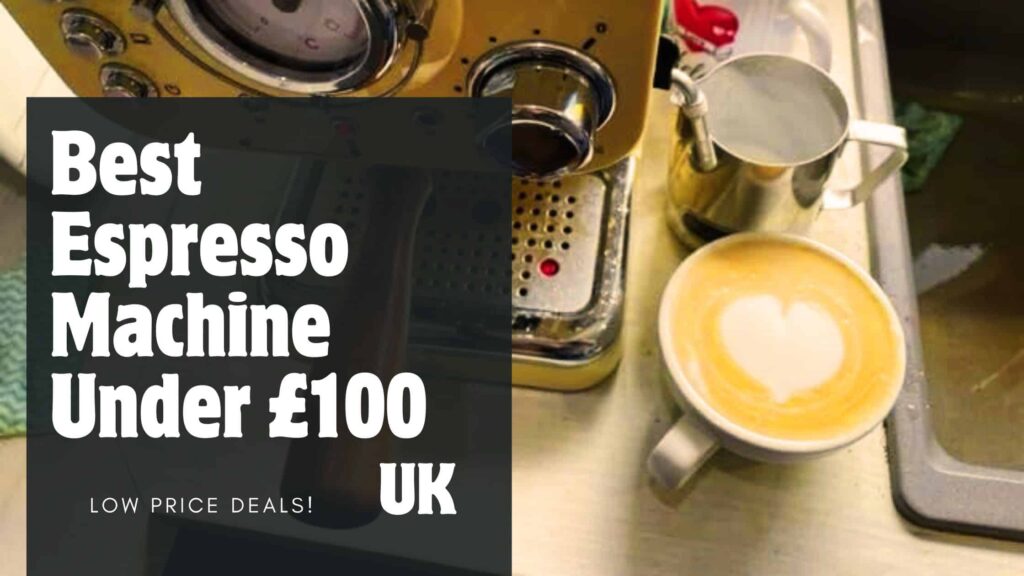Looking for the first hand unboxing experience of best cheap espresso machines under £100 in the uk, this article is for you. Keep reading to find out the ideal deal.
If you’re anything like me, you’ve probably found yourself in need of a reliable and affordable espresso machine to kickstart your mornings. I’ve spent weeks, even months, testing various options to find the perfect fit for my coffee cravings. In this article, I’ll be sharing my insights on the most budget-friendly espresso machines available in the UK.
Let’s clear up some terminology here. When I mention conventional semi-automatic espresso machines, I’m talking about the go-to choice for most folks seeking a wallet-friendly espresso experience. These are sometimes called semi-auto manual espresso machines. Don’t fret if these terms sound confusing; I’ll break them down.
“Semi auto manual” refers to espresso machines that use pumps, not the fully manual ones with levers and pistons for pressure. Now, what exactly is “cheap” in the context of espresso machines? Well, that’s where subjectivity comes into play.
What one person considers affordable, another might see as a splurge. It’s all relative. For instance, you could argue that a machine costing a thousand pounds is a steal compared to one worth several grand. The word “cheap” doesn’t have a universal definition; it varies from person to person. A £300 machine might be considered a budget option compared to a £1000 one.
Espresso machines under £100 often share some common traits:
- Water Heaters with Thermoblocks: These machines typically use thermoblocks for heating water.
- Pressurized Portafilters: You’ll find pressurized baskets, which influence the extraction process.
- Inconsistent Temperature Control: Expect temperature fluctuations that affect the quality of your brew.
- Unreliable Brew Pressure: The brew pressure may not be as consistent as pricier machines.
- Build and Design Quality: Lower-cost machines are usually constructed with less expensive materials, impacting their overall build quality.
I’ll elaborate on each machine’s features later, but in a nutshell, these budget-friendly espresso machines are built to a cost, which affects their shot quality. While machines under £300 also have some of these features, they are more pronounced in those under £100.
If you can stretch your budget a bit, I’d recommend looking at options under £200. In my view, the Gaggia Espresso, the latest model from Gaggia, is the best choice under £200. It’s definitely worth the extra £80 if you were initially planning to spend up to £100. Trust me; the upgrade is worth it.
let’s look at our first hand unboxing testing experience review together with the recent buyer reviews.
Best Espresso Machine Under £100 UK– Tried And Tested
Why you can trust Office Ergonomics House Keeping UK: Our expert reviewers spend hours testing and comparing products and services so you can choose the best for you. Find out more about how we test.
let’s look the following
| Espresso Machine Under £100 | Buyer Satisfaction Ratings | Stores |
|---|---|---|
| Swan SK22110BLN Retro | 84% | Low Price Offer |
| De’Longhi Stilosa (Recommend) | 88% | Low Price Offer |
| Russell Hobbs Chester | 90% | Low Price Offer |
| Krups Opio | 80% | Low Price Offer |
| Melitta 1021-12 | 84% | Low Price Offer |
| Breville Bijou | 84% | Low Price Offer |
Swan SK22110BLN Retro
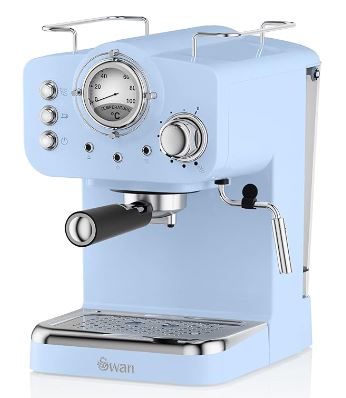
I recently tried out the Swan SK22110BLN Retro Espresso Machine under 100 uk, and it left me with a mix of opinions. First, the aesthetics are on point – it’s a sleek and attractive machine that catches your eye. It’s perfect for those who want a coffee maker that adds a touch of style to their kitchen.
The coffee-making process is relatively straightforward. I found it easy to use, and it consistently produced a decent cup of coffee. The flavor was enjoyable and made my mornings more delightful. See the picture below.
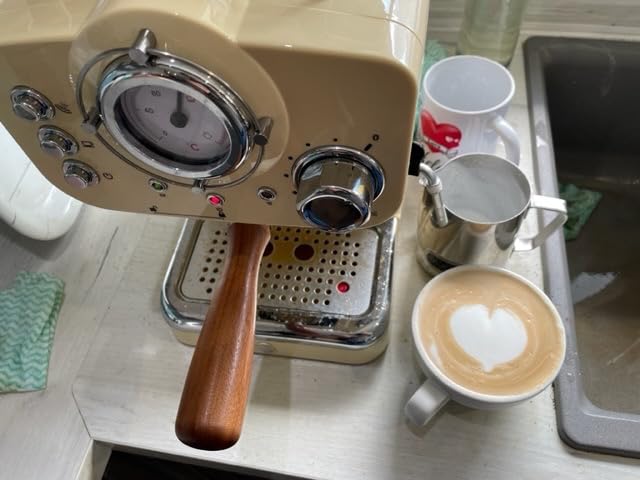
One of the machine’s strengths is its versatility in handling different types of milk, which is a plus if you like experimenting with various coffee styles. The frother, when used correctly, can produce a lovely froth, enhancing your coffee experience.
However, there are some downsides to consider. Firstly, the time it takes to make a single cup of coffee can be quite long. On average, it takes around 10 to 15 minutes for me, and sometimes even longer on bad days. So, if you’re in a rush, this might not be the best choice.
The machine’s pressure can be inconsistent, which impacts the milk-steaming process. This could be discouraging for those aspiring to create latte art. Achieving a strong espresso shot proved challenging, even after experimenting with different coffee beans. It seems to struggle with maintaining consistent pressure.
The Swan SK22110BLN Retro Espresso Machine is notably noisy, and it vibrates quite a bit, which can be disconcerting at first. It’s primarily due to the pump’s power compared to the machine’s size.
One significant issue I encountered was steam leakage, particularly around the dial. It can make the machine messy and potentially problematic to use.
The frother, although capable with standard milk, struggles with alternative milky drinks like hot chocolate or chai. You’ll need to steam the milk separately and then mix in the powder or syrup, which can be an inconvenience.
De’Longhi Stilosa
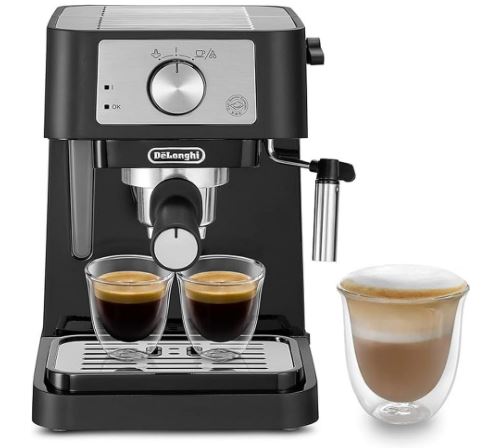
I recently had the opportunity to try out the De’Longhi Stilosa Espresso Machine, and here’s what I found. Once you get the hang of it, this machine can deliver a good espresso. The coffee it produces is quite enjoyable, which is always a pleasant surprise, especially at this price point.
It’s a compact and straightforward coffee machine, perfect for those looking for a basic yet functional coffee maker. The instructions provided may not be the best, but with a bit of practice and perhaps some video tutorials, I managed to master it over a few weeks. The learning curve might be a bit steep, but the effort is worth it, considering the quality of coffee you can eventually achieve.

One standout feature is the milk steamer. It does a decent job, and with some practice, you can froth milk to perfection. It’s a crucial aspect if you enjoy creating frothy coffee drinks like lattes and cappuccinos at home.
However, there are a few drawbacks to consider. While it’s a good machine once you get the hang of it, the learning curve can be steep, mainly due to the unclear instructions. It took some trial and error, watching videos, and seeking advice to master the art of making a decent cup of coffee with this machine.
The steam spout may not be the best, and it could be improved for a smoother coffee-making experience. That said, considering the price, it’s a minor inconvenience.
Overall, the De’Longhi Stilosa Espresso Machine under 100 uk offers a budget-friendly option for those who want to enjoy espresso and frothy coffee drinks at home. It requires some patience and practice to get the most out of it, but the results are worth it. It’s compact, easy to clean, and can produce excellent coffee once you’ve learned the ropes. However, be prepared to put in the effort to master its operation.
Russell Hobbs Chester

I recently put the Russell Hobbs Chester Grind and Brew Coffee Machine to the test, and it turned out to be a convenient companion for my coffee journey. Let me share my experiences and provide a straightforward assessment of this coffee machine.
When it comes to blending power, I’d rate it a solid 3 out of 5. This machine delivers a decent grinding performance when set to the “12 cups” selection, ensuring a satisfactory blend. However, if you prefer a bolder coffee taste, you might find its blending power somewhat lacking. To get a stronger brew, you might need to use more beans, but be cautious about caffeine overdrive!
On the bright side, the timer function is a standout feature, earning a perfect score of 5 out of 5. The ability to program the machine to start brewing at a specific time is a game-changer, ensuring your coffee is ready when you need it most. This feature is a blessing for those with busy schedules, and it makes mornings a breeze.
In terms of cleaning, I’d give it a respectable 4 out of 5. The machine is relatively easy to clean, with removable parts that can be washed separately. However, some nooks and crannies, especially around the grinder blade, require extra attention during cleaning.
The coffee machine also features a warming function for the carafe, keeping your coffee hot for around 35-40 minutes before automatically shutting off. This is a standard feature for coffee machines, but it’s good to have. There’s also an anti-drip function, allowing you to remove the carafe during the brewing process. Just be careful not to pull it out too quickly to avoid messes on the warmer plate.
Now, let’s address the areas where this machine falls short. The blending power, especially for those who prefer a stronger brew, leaves room for improvement. It’s essential to set it to the “12 cups” selection to achieve a satisfactory blend. It’s not a deal-breaker, but it could be better.
While the timer function is excellent, the machine offers limited control over brewing strength. It’s challenging to get a heavily brewed cup. To overcome this, you might need to use more beans, but this can result in an overload of caffeine.
Furthermore, intricate areas, particularly around the grinder blade, demand extra attention during the cleaning process. It’s not the most straightforward machine to clean, and improvements in this aspect would be welcomed.
Krups Opio
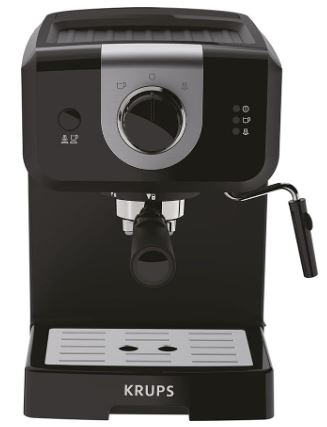
I’ve recently put the Krups Opio Espresso Machine to the test, and it offers a mix of both praises and shortcomings. Let me provide a personal perspective on this coffee machine.
Starting with the positives, the Krups Opio Espresso Machine delivers great coffee, and the crema it produces is second to none. If you appreciate the classic espresso experience, this machine excels in delivering it. The pump’s quality ensures that the coffee it produces is of high standards.
Another significant advantage is the speed at which this machine produces coffee. You won’t find yourself waiting endlessly; it quickly brews your coffee, which is a major plus for those who need their coffee fix promptly.
The design of the coffee holder is well thought out as it clicks into place, preventing over-packing, which can lead to handle damage—a problem I’ve encountered with previous machines.
In short, the Krups Opio Espresso Machine offers an excellent coffee experience with remarkable crema, fast brewing, and practical features.
Now, let’s address the areas where this machine falls short. The primary concern is with the frother. While it’s a crucial component for many coffee enthusiasts, this machine’s frother has its share of issues.
Cleaning the inner metal nozzle of the frother can be quite challenging, as it’s prone to blocking with dried milk residues after each use. The cleaning process becomes a bit of a hassle.
Moreover, the frother’s froth is less dense compared to other machines, making it necessary for some users to invest in a separate milk frother. The machine struggles to produce adequately frothy milk for coffee.
Despite using the frother for an extended duration, the milk never seems to reach the desired temperature. It falls short of delivering hot enough milk for some users.
The positioning and maneuverability of the frother present difficulties, especially when trying to manage a jug underneath it. You may need to make adjustments to your countertop to ensure a proper fit, which isn’t ideal.
In my experience, the difficulties with the frother have led to non-use. This means that I may have paid more for a machine with a frother that I could have found without one. The frother’s practicality and usability seem limited due to these challenges.
In terms of build quality, the Krups Opio Espresso Machine feels comparatively “light” and somewhat cheaper than its predecessors. The previous Krups machine had a more substantial, metal-based design, whereas this one seems less robust.
Melitta 1021-12
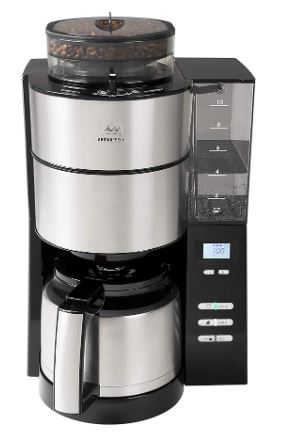
Starting with the positives, the Melitta 1021-12 Espresso Machine under 100 has several remarkable features. The ability to detach the reservoir and the stainless steel carafe significantly eases the cleaning process. In addition, the filter basket is designed for easy removal and cleaning, enhancing user convenience.
Moreover, this coffee machine effectively uses paper filters, eliminating the need for washing permanent nylon or metal mesh filters after each use. Simply replace the used paper filter and you’re ready to brew again, which minimizes the hassle of cleaning.
The Melitta 1021-12 Espresso Machine’s grinder is of excellent quality. It employs a method that abrades coffee beans between cogs, which is preferred by coffee enthusiasts for preserving the beans’ flavor and aroma.
Unlike many other filter coffee machines, this one doesn’t rely on a hotplate to keep the coffee warm. Instead, it utilizes a well-insulated, double-walled, stainless steel jug, which provides more durability and maintains the coffee’s heat for an extended period.
Now, let’s discuss the areas where this machine has room for improvement. Some users have reported that it consumes a significant amount of coffee beans. Additionally, the settings can be somewhat confusing. Users are uncertain whether the “strength” setting, the “cups” setting, or both affect the number of beans ground. This lack of clarity can make brewing more complicated than it should be.
Despite these minor drawbacks, the Melitta 1021-12 Espresso Machine excels in brewing coffee. It offers a user-friendly experience with convenient features like the detachable reservoir and easy-to-clean components. The adoption of paper filters simplifies the cleaning process, and its quality grinder ensures a delightful coffee experience.
This machine’s ability to maintain coffee heat without a hotplate adds to its appeal. However, a bit more clarity in the settings for bean grinding would enhance the overall user experience.
Breville Bijou
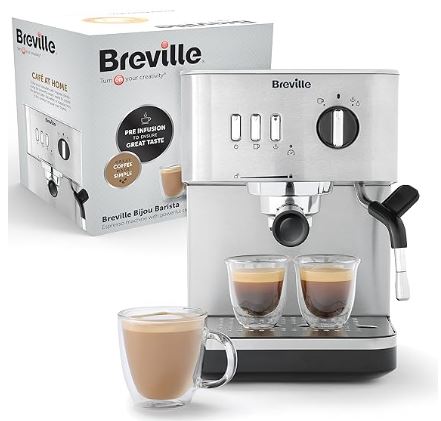
I’ve recently tested the Breville Bijou Espresso Machine, and it offers both positive and negative aspects. Let’s dive into my personal perspective on this budget coffee machine.
Starting with the positives, the Breville Bijou Espresso Machine has garnered commendable reviews. It’s considered one of the best low-end coffee machines available. It’s user-friendly, and setting it up for the first time is a breeze. It’s perfect for beginners, making it easy for anyone to enjoy a delightful cup of espresso.
One of its standout features is the ability to brew excellent-tasting espresso and milk-based coffee once you get the hang of it. The machine includes almost everything you need to get started, with the exception of a metal milk jug for the steam wand. However, a regular cup can be used as an alternative.
The Breville Bijou Espresso Machine provides a budget-friendly way to explore different coffee beans. Users have found it to be a cost-effective choice, especially when purchased on sale or with a discount. The espresso it produces has been praised for its taste and quality.
Despite its praises, the Breville Bijou Espresso Machine is not without its downsides. For instance, the steam wand tends to overheat the machine, requiring a cooling period of around 10-20 minutes between uses. This can be a limitation if you want to make multiple espressos or milk-based coffees in quick succession.
Additionally, the portafilter, although functional, feels a bit cheap to some users. The design of the notch basket can make it tricky to remove after use, especially after dealing with coffee grounds. Cleaning and maintaining the portafilter can be a bit more of a hassle.
The machine doesn’t dispense a predefined measure of coffee, which means you have to manually stop the brewing process to avoid over-pouring. While this is suitable for making Americanos, it can be less convenient when crafting espressos.
How We Test
Testing espresso machines is a meticulous process that involves various aspects to evaluate their performance, quality, and functionality. Below is an overview of how espresso machines are typically tested:
1. Initial Setup and Configuration:
- Unboxing and assembling the espresso machine according to the manufacturer’s instructions.
- Configuring initial settings, such as water hardness, temperature, and coffee strength adjustments.
2. Testing Brewing Process:
- Testing the machine’s brewing capabilities by pulling a series of espresso shots.
- Evaluating the machine’s consistency in maintaining the desired water temperature and pressure.
- Examining the quality of espresso shots, including crema, flavor, and temperature.
- Testing the machine’s ability to brew various coffee styles, such as espresso, cappuccino, or latte.
3. Milk Frothing and Steaming:
- Assessing the milk frothing and steaming capabilities, if applicable.
- Evaluating the quality of frothed milk, including its texture and temperature.
- Determining the ease of use for frothing and steaming wands.
4. Coffee Bean Grinder (if equipped):
- Testing the integrated coffee bean grinder’s consistency and grind settings.
- Evaluating the grinder’s performance in producing the right coffee grind size for espresso.
- Ensuring the grinder’s durability and maintenance requirements.
5. Water Reservoir and Dispensing:
- Assessing the water reservoir’s capacity and ease of refilling.
- Testing the machine’s dispensing speed and the ability to adjust the coffee strength.
6. Cleaning and Maintenance:
- Evaluating the ease of cleaning components like drip trays, drip grids, and coffee puck containers.
- Checking the machine’s maintenance requirements, including descaling and cleaning the coffee group.
7. User Interface and Controls:
- Testing the machine’s control panel, touchscreen, or button interface for ease of use.
- Evaluating the intuitiveness of the control settings for customizing coffee preferences.
8. Build Quality and Durability:
- Assessing the overall build quality and materials used in the machine’s construction.
- Evaluating the machine’s long-term durability and resistance to wear and tear.
9. Noise and Energy Consumption:
- Measuring the machine’s noise level during operation.
- Assessing its energy consumption and efficiency.
10. Comparing Features and Functionality: – Comparing the espresso machine’s features with those of similar models and brands. – Evaluating unique functions or technologies that set the machine apart from others.
11. User Feedback and Long-Term Performance: – Gathering user feedback and reviews for long-term performance insights. – Monitoring the espresso machine’s performance over an extended period to identify any issues that may arise with regular use.
12. Quality of Espresso: – Conducting taste tests with a panel of coffee enthusiasts to assess the quality of espresso produced by the machine. – Considering factors such as crema, flavor, aroma, and overall coffee experience.
13. Final Assessment: – Providing an overall assessment, including strengths and weaknesses, to guide potential buyers. – Offering recommendations and highlighting any specific use cases where the machine excels.
This comprehensive testing process ensures that espresso machines are thoroughly evaluated for their brewing quality, functionality, ease of use, and overall performance. The results of these tests help consumers make informed decisions when choosing the right espresso machine for their needs.
Read Next:
- Best Espresso Machine Under £200 UK
- Best Bean To Cup Coffee Machine Under £100
- Best Bean To Cup Coffee Machine Under £300

James Coffee Maker
James Coffee is a passionate coffee enthusiast and a dedicated professional in the coffee industry. With years of experience and a deep love for all things coffee-related, James brings a wealth of knowledge and expertise to the world of coffee makers.
As a coffee enthusiast, James understands the importance of a good cup of coffee to kickstart the day or to enjoy during quiet moments. His dedication to exploring different coffee brewing methods, experimenting with coffee beans from around the world, and mastering the art of coffee-making shines through in his work.
James's professional background adds a layer of expertise to his passion for coffee. He has worked closely with coffee makers, roasters, and baristas, gaining valuable insights into the intricacies of coffee brewing and flavor profiles. His commitment to quality and innovation drives him to explore the latest coffee maker technologies and share his findings with fellow coffee lovers.
Through his articles and reviews, James Coffee aims to inspire and educate coffee enthusiasts of all levels. Whether you're a novice coffee drinker or a seasoned aficionado, James's expertise and enthusiasm will guide you in choosing the perfect coffee maker to elevate your coffee experience.

Amy lockwood
Amy Lockwood is a well-known expert in the field of house keeping. With a passion for testing and evaluating the latest products, she provides her readers with informative and unbiased reviews. Her knowledge and expertise have made her a trusted source for those in the market for new house keeping appliances. Whether you're looking for a new refrigerator, oven, purifier or coffee maker, Amy's insightful reviews will help you make an informed decision.

We team is a leading authority in office ergonomics and housekeeping solutions, bringing years of expertise to the table. As a key member of our “Expert Reviews” team at Office Ergonomics House Keeping, I and We rigorously tests and compares a wide range of products available in the UK market. My or our meticulous approach ensures each item undergoes comprehensive evaluation, from unboxing to in-depth analysis over several months. Trusted for his authoritative insights, I provides reliable and accurate reviews that help you make informed decisions. With a commitment to enhancing comfort and productivity, Our expert-backed recommendations are your go-to source for top-notch office ergonomic and housekeeping solutions.
